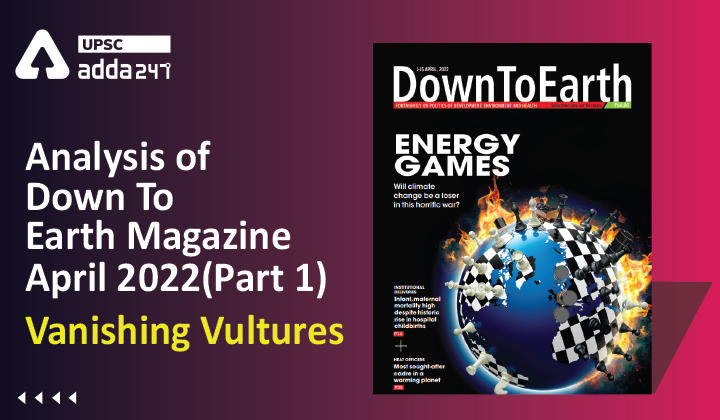Table of Contents
Analysis Of Down To Earth Magazine: ”Vanishing Vultures”
Relevance
GS 3: Conservation, Government Policies & Interventions
Context
- On March 14, the Bombay Natural History Society wrote a letter urging the Union Ministry of Environment, Forest and Climate Change (MOEFCC) to ban the use of three veterinary drugs known to kill vultures in the country.
- This risk to the vulture population came sixteen years after India banned the veterinary use of diclofenac to save its vultures.
Which are the three other drugs that revive the old challenge?
- The rampant use of the three non-steroidal anti-inflammatory drugs (NSAIDs) threatens to undo the Centre’s two decades of work to arrest the dwindling vulture population in the wild.
- The three drugs are—aeclofenac, ketoprofen and nimesulide.
- Surprisingly, these drugs were introduced as alternatives to diclofenac, the NSAID that India banned in 2006 for animal use because it caused widespread vulture deaths.
What is the new challenge?
- Deaths caused by NSAIDs are invisible. Birds die two-three days after ingesting the medicine, making it difficult to establish a clear link.

- India has slowed down the vulture mortality rate but has not stabilised the population.
What did the Data say?
- Vultures were quite common till the 1980s. Currently, eight species in the country face extinction.

- The country’s vulture population crashed from over 40,000 in 2003 to 18,645 in 2015, as per the last vulture census conducted by intergovernmental body BirdLife International.
Vulture’s IUCN Status
- The Indian vulture (Gyps indicus) is an Old World vulture native to India, Pakistan and Nepal.
- It has been listed as Critically Endangered on the IUCN Red List since 2002, as the population severely declined.
India’s vulture conservation action plan for 2020-25
- It recommends a ban on the veterinary use of the three drugs.
- It adds that the Drug Controller General of India (DCG) institute a system that removes a drug from veterinary use if it is found to be toxic to vultures.
- The country is also a signatory to the Convention on Migratory Species’ Multi-species Action Plan to Conserve African-Eurasian Vultures, which recognises NSAIDS as a major threat to vultures in India.
- Still, little seems to have moved on the ground.



 TSPSC Group 1 Question Paper 2024, Downl...
TSPSC Group 1 Question Paper 2024, Downl...
 TSPSC Group 1 Answer key 2024 Out, Downl...
TSPSC Group 1 Answer key 2024 Out, Downl...
 UPSC Prelims 2024 Question Paper, Downlo...
UPSC Prelims 2024 Question Paper, Downlo...
